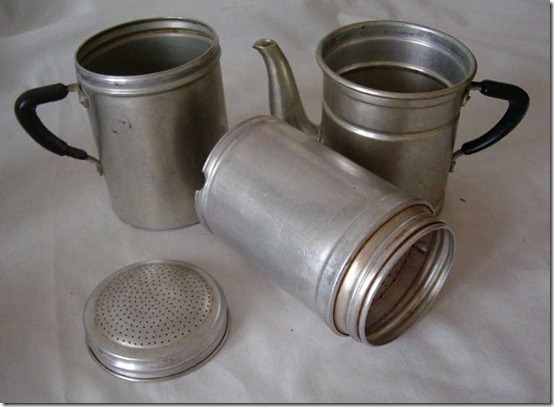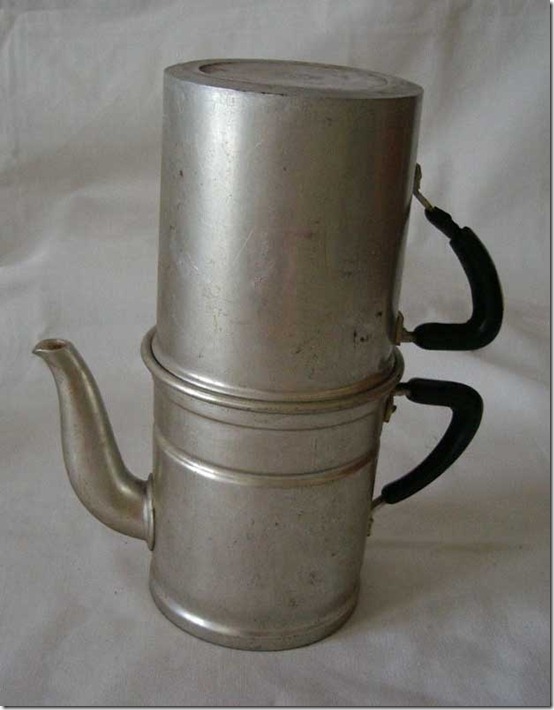La Caffettiera Napoletana Posted by Serena on Oct 19, 2011 in Culture
The other day my friend Annalisa, who is in the middle of moving house, opened one of her packing boxes and found my dear old caffettiera napoletana that I had lent to her sometime ago. La caffettiera napoletana is not very common anymore in Italian households, but until the Fifties it used to be the most widespread coffee maker. It’s a very simple gadget composed of four lightweight aluminium cylindrical parts, and it has no rubber seals that can melt or safety valves that can get blocked. However, it’s a bit like a puzzle, and if you don’t fit the four components together correctly, you won’t have any coffee.
When I make coffee in the caffettiera napoletana I first fill up the lower cylinder with water. This part of the caffettiera has got a handle and a small hole near the top which allows for the flow of air and water (top left in the photo above), so when I fill it up I make sure that the level of water is about one centimetre below the hole.
I then insert the filter (middle of photo), and I put ground coffee in it. The filter has a groove on one side, which must perfectly align with the hole in the outer shell. Then I screw on the lid which is the bit that looks like a salt or pepper pot in the photo.
On top of all this I slot the part that has the spout and a handle, making sure that the handles on both the upper and lower sections are perfectly aligned (see below). Now that the caffettiera napoletana is ready I put it on the stove and wait.
After a few minutes the water starts boiling and a few drops escape from the little hole in the lower cylinder. It’s time to turn the heat off and carefully turn the napoletana ‘capovolta’ = ‘upside down’ in order to allow the water to slowly percolate through the coffee and collect in the container with the spout.
Turning the caffettiera napoletana over is the trickiest part of all: you need to hold both handles at the same time, one with each hand. If you accidentally pull the two handles together, hot boiling water will start pouring out from the joint in the middle, making a real mess! If on the other hand you slightly rotate the top and the bottom parts in opposite directions, they will come out of alignment blocking the little hole, which means that the air won’t get through and the water won’t percolate! It takes a bit of practice to get everything in the right order and to master the turning technique, but the result is a delicate aromatic coffee.
When I lived in England I used to prefer the napoletana because electric cookers were very common there and I didn’t like coffee made in a mocha on an electric stove. It always tasted too strong, almost stewed. Here in Italy I have a gas cooker, but I only use the napoletana to make caffè d’orzo = barley coffee, a nice warming drink, which is naturally caffeine free. It’s made from ground roasted barley and is a very common coffee substitute. Roasted barley doesn’t work well in the normal caffettiera mocha because it goes very sticky whet it’s wet, a bit like mud, but it’s perfect in the caffettiera napoletana.

Build vocabulary, practice pronunciation, and more with Transparent Language Online. Available anytime, anywhere, on any device.






Leave a comment: